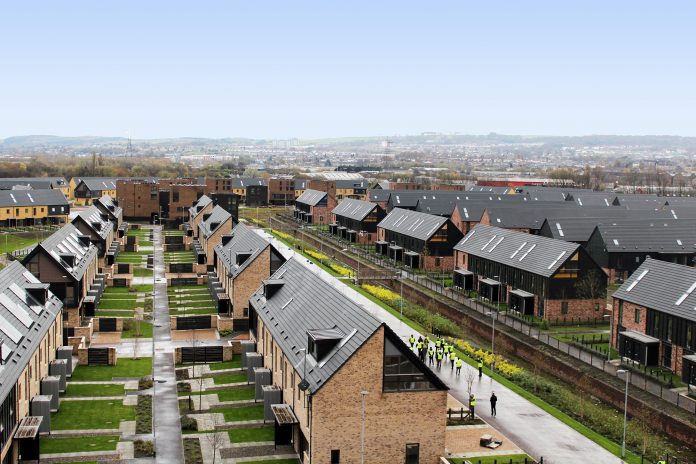Professor Robert Hairstans, head of Edinburgh Napier University’s Centre for Offsite Construction & Innovative Structures, discusses a new strategic partnership that brings together digital technologies, academic research and industry-driven innovation
From tall timber buildings to micro manufacture, the products, systems and approaches necessary for the delivery of a sustainable built environment are available. Appropriate application to the context requires informed decision-making enabled by digital tools.
Establishing a Trimble Technology lab at Edinburgh Napier presents a unique opportunity to create the right environment to furnish the sector with the next generation of individuals that have the necessary knowledge and skills to move a sustainable built environment forward.
Construction productivity has stagnated; however, increasing construction output will only serve to exacerbate its current negative environmental impact. The construction and use of buildings in the EU accounts for about half of all extracted materials and energy consumption and about a third of water consumption.
The whole-life performance of built assets therefore needs to be fully considered. Embracing offsite approaches to construction delivery utilising renewable resources combined with digitisation offers a solution. Digital integration of the supply chain from forest floor to built asset is ambitious but can be made a reality with the correct ingredients and endeavour.
Industrialised timber systems
Edinburgh Napier University is recognised for research and teaching on industrialised timber systems including pre-manufactured closed panel and mass timber products such as cross laminated timber. The utilisation of timber in construction sequestrates carbon and via a fabric first approach significantly reduces whole-life environmental impact.
Designed for manufacture and assembly using digital technologies, they can be delivered efficiently via a quality assured factory approach. Taking disassembly and future use into account, conformity with the circular economy can be readily achieved. It is about a change in construction culture and embracing an alternative mindset, moving away from the traditional construction delivery models of low productivity utilising non-renewable resources.
Research and teaching partnership
The establishment of the Trimble Technology Lab at Edinburgh Napier is the culmination of an already 10-year long research and teaching partnership. The objective is to shape the future delivery of the sustainable built environment through digital enablement.
The partnership originated on this basis, with the university embedding research findings into Trimble Tekla Tedds software as a route to impact. Tekla Tedds is the UK industry-standard software for engineering design.
Embedding research into Tedds, engineers throughout the UK had ready access to it facilitating the uptake of the European structural codes of practice (which were superseding British Standards at the time), as well as the innovative solutions derived to resolve technical detailing issues associated with pre-manufactured approaches.
The outputs of this partnership have been practically demonstrated on numerous projects working with industry partners including showcase examples such as the Glasgow Commonwealth Games athletes’ village in 2014 and more recently the Dyson Institute of Engineering and Technology student village completed in 2018.

CCG iQ closed panel timber frame system
The CCG iQ closed panel timber frame system used standard details from the research; these panels were then capable of being fully enhanced in the factory environment for on-site efficiency. The Carbon Dynamic factory-fabricated cross-laminated timber volumetric modules also had technical connection challenges resolved utilising the derived software.
The result was ambitious cantilevers being achieved in the final array of standardised units. Prior to installation the maximum cantilever was structurally tested for deflection under service load conditions with a feedback loop for the purposes of validating the analytical models.
Integral to this application of research into practice was the involvement of student talent via Edinburgh Napier’s award-winning programme for industry engagement, the Built Environment Exchange. With academic supervisory support, industry engagement and access to the latest in software technologies students were able to provide additional value to the delivery process as well as accelerate their careers by ascertaining new knowledge and practical skills.
The artwork on the walls of the Trimble Technology lab at Edinburgh Napier University depicts these two projects and therefore represents what is achievable via the triangulation of digital technologies, academic research and industry-driven innovation.
The partnership is building upon this success and moving on to the next level via access to Trimble’s broad portfolio of building construction solutions support and ready access to Trimble’s industry-leading solutions such as the Trimble® XR10 HoloLens with hardhat, Trimble mechanical total stations, a Trimble unmanned aircraft system (UAS) and a handheld scanner.
Advanced software solutions
Advanced software solutions include RealWorks® scanning software, Trimble Business Centre, Tekla® Structures, Tekla Structural Designer, Tekla Tedds, Trimble Connect and the company’s popular 3D modelling software, SketchUp Pro.
The timing of this phase of the partnership converges with Industry 4.0 and the necessity to accelerate digitisation of a sustainable built environment and the whole lifecycle of built assets. This goes beyond Building Information Modelling moving towards an ecosystem of digital twins where the digital model is connected to the physical asset allowing on-going information enrichment.
This has the potential to unlock the use of artificial intelligence (AI) and correspondingly machine learning, where systems learn from data rather than through explicit programming. Future adoption of such an approach will start to take hold in the construction and offsite timber sectors.
A series of Gemini Principles have been developed to facilitate future adoption (Table 1). Creating a feedback loop to the design and manufacturing process can help improve efficiencies and further optimise performance, and integration with the supply chain through enterprise resource planning (ERP) can stimulate a holistic optimisation process.
| Section name
Purpose: Must have clear purpose |
Public good
Must be used to deliver genuine public benefit in perpetuity |
Value creation
Must enable value creation and performance improvement |
Insight
Must provide determinable insight into the built environment |
| Trust:
Must be trustworthy |
Security
Must enable security and be secure itself |
Openness
Must be as open as possible |
Quality
Must be built on data of an appropriate quality |
| Function:
Must function effectively |
Federation
Must be based on a standard connected environment |
Curation
Must have clear ownership, governance and regulation |
Evolution
Must be able to adapt as technology and society evolve |
Data-driven manufacturing
Optimal performance using standardised systems and processes in order to meet client and context-specific requirements necessitates a digitally enriched product family architecture that can be mass customised. The capabilities of the manufacturing process, ability of the supply chain to respond and requirements of the logistical processes require to be considered at the design stage. Automating the formation of these building components as part of a production flow process will further require enhanced utilisation of information and communication technology.
Edinburgh Napier University is exceptionally well-positioned to pioneer research, teaching and learning in this respect partnering with Trimble and industry with Construction Scotland Innovation Centre (CS-IC) support including access to the Innovation Factory whereby advanced manufacturing techniques can be trialled and tested prior to full production.
This presents the opportunity to undertake data-driven manufacturing for product assessment with implementation into pilot project applications including a feedback to the digital model for optimisation. Capturing this information and presenting it in an interactive and virtual environment has the capability to create an immersive learning experience with meaningful insight to the solutions being derived.
The establishment of a Trimble Technology Lab at Edinburgh Napier University creates a focal point with access to the necessary tools and support to enable the digital transformation of the built environment by means of leveraging stakeholder engagement while mobilising the next generation of student talent.
Professor Robert Hairstans
Head of the Centre for Offsite Construction & Innovative Structures
Edinburgh Napier University
Tel: +44 (0)131 455 2891
LinkedIn: cocis

















